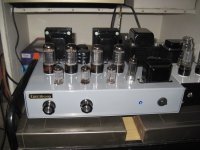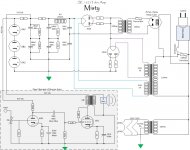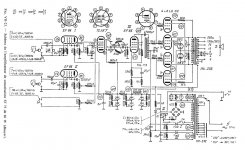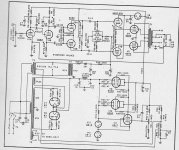Tony - it really depends on how much screen current is being drawn at full power. In AB1, it is 8 mA, or 32 mA for 4 tubes. Octal VR have 40 mA capability. I have done it and it works just fine. Other people have done it too without any problem:
http://www.diyaudio.com/forums/tubes-valves/85703-807-screen-regulation.html
http://www.diyaudio.com/forums/tubes-valves/85703-807-screen-regulation.html
This issue is non-issue and not worth arguing about. Any amplifier will distort if overdriven. Turn it down a notch, problem solved.
that's the idea.......and no one is forcing you to use G2 regs if you don't feel like it.....
...and no one is forcing you to use G2 regs if you don't feel like it.....
Exactly my point!
I wish there was a way to earmark your post. You pinned down so many critical issues about loading with clarity, that I would recommend it as required reading material for tube amplifier designers - both beginner and advanced.
While most people (including me) start/started with taking operating points from datasheets, knowing how loading impacts on power supply demand, and other parameters, allows much greater range of experimentation with better results. The advantages of higher loading are vastly under-utilized.
Cheers,
Janos
Janis, I don't know what to say... I'm actually speechless, which takes a lot to happen. I take the compliment with humbleness. Dont want head swelling... sometimes the bigger the head gets, the more closed minded it gets...not room for growth, just a lot of room for rattling around
Thank you again for your post.
It not simply reverts. G2 also controls anode current, so chainsaw modulation of it's voltage caused by ignition voltage of VR tube higher than glowing one modulates anode current causing peaks sounding nasty.
Did you get it finally?
I am out, sorry... PLEASE CLICK HERE TO OPEN THE DATASHEET! - during 2 pages you are arguing about irrelevant topics instead of trying to understand the mistake of powering G2 from a parametric stabilizer with VR tube.
i´ve seen parallel gas-stabs strings in rf amps, each had voltage balancing resistors
fet follie is better..
It would be fine in case of parallel stab Zener, but a VR tube unfortunately has higher ignition voltage than one than it stabilizes when glows, so the follower is the must when powering grids of output tubes in power amps.
Here is an example, how I use screen grid current sensors, for absolutely-never-clipping amps, kind of fool proof. When bright red LED flashes, volume has to be turned down to avoid compression.
Checking anti-clipping protection... Red LED shows it. - YouTube
Here is an example, how I use screen grid current sensors, for absolutely-never-clipping amps, kind of fool proof. When bright red LED flashes, volume has to be turned down to avoid compression.
Checking anti-clipping protection... Red LED shows it. - YouTube
Anatoly - this opinion of yours is contrary to the existence of numerous successful designs using VR-regulated screens without followers.
That numerous designs either have lower variations of G2 current, or it is much smaller, than in a SE amp with 807 output, i.e. not enough to extinguish glow of the VR tube on peaks caused by crest-factor in the music. What is valid in one context does not work in another one. But when somebody for an argument refers to authorities it pisses me off. You either show me real data to prove me mistaken (except in some different cases somebody did that), or stop arguing.
Do you understand now why I do not go to Audio Portal and other Russian forums? Because of people with your attitude. 😛
Welcome to my ignore list: 😀
Do you understand now why I do not go to Audio Portal and other Russian forums? Because of people with your attitude. 😛
Welcome to my ignore list: 😀
Last edited:
0.5-8 mA variations we talked about are not that large.
I don't see anything wrong with my attitude. It is a purely technical discussion. Stay cool.
I don't see anything wrong with my attitude. It is a purely technical discussion. Stay cool.
there are readers who will find that regulated G2 appeals to them,
so it is to them that we address our posts to.......
there are many ways of solving the G2 regulation issue...
those who would like to stick to the traditional solutions, that is also fine,
pick your poison....
so it is to them that we address our posts to.......
there are many ways of solving the G2 regulation issue...
those who would like to stick to the traditional solutions, that is also fine,
pick your poison....
fet follie is better..
absolutely.....others who have not tried, please do and be pleasantly surprised,
there are those who advocate dc filament regulators for DHT's.....why not G2?
I get it. One thing I don't understand is what's the big deal about VR tube extinguishing. Once it stops conducting, the circuits simply reverts to screen supply via voltage dropping resistor until VR ignites again.
I'm not sure if this matters, but I read that a VR tube going off then igniting repeatedly is not good for their longevity... plus ignition does take a split second or so...enough to be heard in the music.
I have VR regulation in the last amp I made, and there is a definite difference with or without the VR tube ignited...so I'm guessing it won't sound the best upon re-ignition.
I am using the VR tubes to regulate the pre-amp tubes on the last design I made.
I know it is triode SE strapped, but maybe something similar can be used for G2 regulation... I wonder if a thyratron such as a 2050 could be used some how... it can pass more current than VR's and is a diode...
Then again...maybe scrap that idea until I try it out...
Attachments
Last edited:
^yes, that is the one thing we do not want happen with our amps as Anatoly have emphasized...
if you can design your amp so that does not happen, then that is good...
if you can design your amp so that does not happen, then that is good...
I have VR regulation in the last amp I made, and there is a definite difference with or without the VR tube ignited...so I'm guessing it won't sound the best upon re-ignition.
I've been there, done that, and decided that I prefer compression instead of clipping to tooth-grinding cracking sound on peaks that suddenly happen.
I'm not sure if this matters, but I read that a VR tube going off then igniting repeatedly is not good for their longevity... plus ignition does take a split second or so...enough to be heard in the music.
I have VR regulation in the last amp I made, and there is a definite difference with or without the VR tube ignited...so I'm guessing it won't sound the best upon re-ignition.
I am using the VR tubes to regulate the pre-amp tubes on the last design I made.
I know it is triode SE strapped, but maybe something similar can be used for G2 regulation... I wonder if a thyratron such as a 2050 could be used some how... it can pass more current than VR's and is a diode...
Then again...maybe scrap that idea until I try it out...
I am not arguing that extinguishing and re-ignition of a VR tube is a benign thing. If it happens, it is horrible. If it was about a guitar amp that is on purpose driven into distortion, this is a real issue that would justify over-complicated g2 supply.
But we are talking about hifi amplifier whose 120 W is a reserve to insure lowest possible distortion at its normal use level of 5 W. Even at 120 W, g2 current of four 807 tubes will not exceed the capability on one VR tube set at 40 mA idle, and there will be no extinguishing. 115 W is more than sufficient reserve for any music signal spike contingency.
Anything can be driven into horrific distortion, even an amplifier with active g2 regulation. Just ramp up the input far enough.
.....in my Stax amp i used first a plate resistors on ecc83 (warm vintage sound), but when tried fet gyrator ..
detailed and crisp
also found that Rk bypass was making the sound bad. with plenty gain now i could remove caps.
one stage, and hell of difference
detailed and crisp
also found that Rk bypass was making the sound bad. with plenty gain now i could remove caps.
one stage, and hell of difference
- Home
- Amplifiers
- Tubes / Valves
- 807 Sound Quality?



